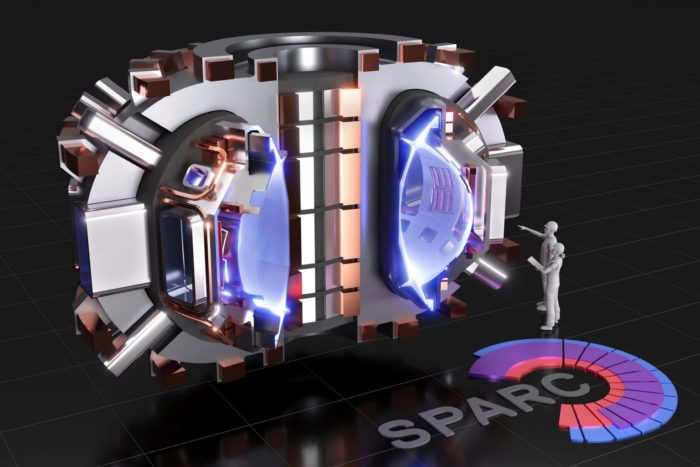Sep 16 2021
Another Fusion Breakthrough
 About a month ago I wrote about a milestone achieved by the National Ignition Facility (NIF) which is using the inertial confinement method to achieve fusion of hydrogen into helium. Briefly, they achieved “burning plasma” where heat from the fusion provides energy for further fusion. They are only about 70% of the way to ignition, where the fusion is self-sustaining with only its own energy.
About a month ago I wrote about a milestone achieved by the National Ignition Facility (NIF) which is using the inertial confinement method to achieve fusion of hydrogen into helium. Briefly, they achieved “burning plasma” where heat from the fusion provides energy for further fusion. They are only about 70% of the way to ignition, where the fusion is self-sustaining with only its own energy.
The NIF uses lasers to compress the hydrogen plasma to sufficient heat and density for fusion to occur. The other approach to achieving fusion is magnetic confinement, using powerful magnetic fields to squeeze the plasma to incredible density and heat, so that the hydrogen atoms are moving fast enough that occasionally two will collide with enough force to cause fusion. The magnetic confinement approach is all about the magnets – if we have magnets that are powerful and efficient enough, we can make fusion. It’s that simple. After decades of plasma research there are multiple labs around the world that can use magnetic confinement to get hydrogen to fuse. But we have yet to achieve “ignition”. Also, ignition is not the final goal, just one more milestone along the way. We need to go beyond ignition, where the fusion process is producing more than enough energy needed to sustain the fusion, so that some of the excess energy can be siphoned off and used to make electricity for the grid. That’s the whole idea.
MIT’s Plasma Science and Fusion Center (PSFC) in collaboration with Commonwealth Fusion Systems (CFS) has their own magnetic confinement fusion experiment called SPARC (Soonest/Smallest Private-Funded Affordable Robust Compact). This is a demonstration reactor based on the tokamak design first developed by Soviet physicists. The magnetic field is a doughnut shape with a “D” shape in cross-section. Three years ago they determined that if they could build a magnet that was able to produce a 20 Tesla magnetic field, then the SPARC reactor would be able to produce excess fusion energy. It’s all about the magnets. The news is that they just achieved that very goal, on time despite the challenges of the intervening pandemic.
A Tesla (T) technically is “a field intensity generating one newton (N) of force per ampere (A) of current per meter of conductor.” For comparison MRI imaging systems generally us 1.5T magnets, but the most powerful MRI scanner in the world is 10.5 T. The SPARC team, however, not only needed to create a 20T magnetic but needed to build one that was relatively small. They could not get more powerful simply by building a bigger magnet, which would defeat the purpose. Further still, the magnet needs to be efficient because the whole idea is to generate more energy than consumed. If you need a ton of energy to operate a huge magnet, you may get to fusion, but you won’t be producing net energy.
The ability to make a small powerful 20T magnet was, in turn, made possible by a newly available high temperature superconducting material (yttrium barium copper oxide, YBCO). A superconductor is a material that can conduct electricity without any resistance, so no energy is lost to heat. Many materials are potentially superconductors, if you cool them enough (to within 15 K or less above absolute zero) but few maintain their superconducting state at relatively high temperatures – still very cold, but above the temperature of liquid nitrogen makes them feasible to use. YBCO maintains superconductivity up to 77 K, which is exactly the temperature of liquid nitrogen.
Three years ago YBCO became commercially available. It can be made into thin ribbons, and the SPARC team decided to design a small powerful superconducting magnet out of the material. Simulations published over the last few years predict that a 20T magnet would allow for net energy production using the SPARC design. They now have the 20T magnet. All that remains is to build the actual SPARC fusion energy reactor. That will be the final demonstration that the design works. If all goes well, they can then build ARC reactors, which are scaled up for actual commercial energy production.
Optimistically the team believes they can complete an ARC rector by 2027. We’ll see if this is realistic, and as always, a lot will depend on funding. The estimated cost of constructing one ARC facility is 4-5 billion dollars. Will this be worth it? That’s a complicated question depending on lots of variables about which people will argue. What are the costs of climate change? What are the comparable costs of next generation fission reactors? How viable is an energy system of mostly intermittent renewable energy? How much can the cost of an ARC reactor come down if we build a thousand of them around the world? How reliable will these reactors be, and how long will their production life be?
At the very least it seems like a worthwhile investment to get fusion technology across the finish line, to hedge our bets against other options at decarbonizing the energy infrastructure. If it works out well, fusion reactors can be a source of reliable, on demand, low carbon energy. They would replace in the energy mix coal-fired plants, then natural gas plants, and eventually fission plants. Also, it seems likely that once we have operational net-energy producing fusion power plants, the technology will continue to improve.
The SPARC team’s approach is to get there by going faster, smaller, cheaper. The new magnet, built on a new superconducting material, may get them there.






